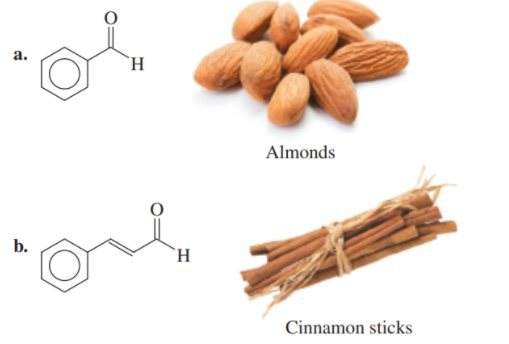
EP BASIC CHEMISTRY-STANDALONE ACCESS
6th Edition
ISBN: 9780134999890
Author: Timberlake
Publisher: PEARSON CO
expand_more
expand_more
format_list_bulleted
Textbook Question
Chapter 17, Problem 85APP
Classify each of the following according to its functional

Expert Solution & Answer
Want to see the full answer?
Check out a sample textbook solution
Students have asked these similar questions
Draw the mechanism to make the alcohol 2-hexanol.
Name the following molecules using IUPAC.
Identify each alcohol in the molecule as either primary, secondary, or tertiary.
Chapter 17 Solutions
EP BASIC CHEMISTRY-STANDALONE ACCESS
Ch. 17.1 - Prob. 1PPCh. 17.1 - Prob. 2PPCh. 17.1 - Prob. 3PPCh. 17.1 - Prob. 4PPCh. 17.1 - Prob. 5PPCh. 17.1 - Prob. 6PPCh. 17.1 - Prob. 7PPCh. 17.1 - Prob. 8PPCh. 17.1 - Prob. 9PPCh. 17.1 - Prob. 10PP
Ch. 17.1 - Prob. 11PPCh. 17.1 - Draw the condensed structural formula for each of...Ch. 17.1 - Prob. 13PPCh. 17.1 - Prob. 14PPCh. 17.1 - Prob. 15PPCh. 17.1 - Prob. 16PPCh. 17.1 - Prob. 17PPCh. 17.1 - Prob. 18PPCh. 17.2 - Prob. 19PPCh. 17.2 - Identify each of the following as an alkane,...Ch. 17.2 - Prob. 21PPCh. 17.2 - Prob. 22PPCh. 17.2 - Prob. 23PPCh. 17.2 - Prob. 24PPCh. 17.2 - Draw the condensed structural formula for the...Ch. 17.2 - Prob. 26PPCh. 17.2 - Prob. 27PPCh. 17.2 - Prob. 28PPCh. 17.2 - Prob. 29PPCh. 17.2 - Prob. 30PPCh. 17.2 - Prob. 31PPCh. 17.2 - Prob. 32PPCh. 17.3 - Prob. 33PPCh. 17.3 - Prob. 34PPCh. 17.3 - Prob. 35PPCh. 17.3 - Draw the line-angle formula for each of the...Ch. 17.4 - Prob. 37PPCh. 17.4 - Prob. 38PPCh. 17.4 - Prob. 39PPCh. 17.4 - Write the common name for each of the following:...Ch. 17.4 - Draw the condensed structural and line-angle...Ch. 17.4 - Draw the condensed structural and line-angle...Ch. 17.5 - Write the common name for each of the following:Ch. 17.5 - Write the common name for each of the following:Ch. 17.5 - Prob. 45PPCh. 17.5 - Prob. 46PPCh. 17.5 - Prob. 47PPCh. 17.5 - Draw the condensed structural formula for a and b...Ch. 17.6 - Prob. 49PPCh. 17.6 - Write the IUPAC and common name (if any) for each...Ch. 17.6 - Prob. 51PPCh. 17.6 - Prob. 52PPCh. 17.6 - Prob. 53PPCh. 17.6 - Prob. 54PPCh. 17.6 - Prob. 55PPCh. 17.6 - Prob. 56PPCh. 17.6 - Prob. 57PPCh. 17.6 - Write the IUPAC and common names, if any, for each...Ch. 17.6 - Draw the condensed structural formulas for a and b...Ch. 17.6 - Draw the condensed structural formulas for a and b...Ch. 17.7 - Write the common name for each of the following:...Ch. 17.7 - Prob. 62PPCh. 17.7 - Prob. 63PPCh. 17.7 - Prob. 64PPCh. 17.7 - Prob. 65PPCh. 17.7 - Prob. 66PPCh. 17.7 - Prob. 67PPCh. 17.7 - Prob. 68PPCh. 17.7 - Prob. 69PPCh. 17.7 - Prob. 70PPCh. 17.7 - Prob. 71PPCh. 17.7 - Prob. 72PPCh. 17 - The chapter sections to review are shown in...Ch. 17 - The chapter sections to review are shown in...Ch. 17 - Prob. 75UTCCh. 17 - Prob. 76UTCCh. 17 - Prob. 77APPCh. 17 - Prob. 78APPCh. 17 - Prob. 79APPCh. 17 - Prob. 80APPCh. 17 - Prob. 81APPCh. 17 - Prob. 82APPCh. 17 - Prob. 83APPCh. 17 - Prob. 84APPCh. 17 - Classify each of the following according to its...Ch. 17 - Classify each of the following according to its...Ch. 17 - Name each of the following aromatic compounds:...Ch. 17 - Prob. 88APPCh. 17 - Prob. 89APPCh. 17 - Draw the structural formula for each of the...Ch. 17 - Prob. 91APPCh. 17 - Prob. 92APPCh. 17 - Draw the condensed structural formula for each of...Ch. 17 - Draw the condensed structural formula for each of...Ch. 17 - Write the IUPAC name for each of the following:...Ch. 17 - Write the IUPAC name for each of the following:...Ch. 17 - Draw the condensed structural formulas for a and b...Ch. 17 - Prob. 98APPCh. 17 - Prob. 99APPCh. 17 - Prob. 100APPCh. 17 - Prob. 101APPCh. 17 - Draw the condensed structural formula for each of...Ch. 17 - Prob. 103APPCh. 17 - Prob. 104APPCh. 17 - Prob. 105CPCh. 17 - Prob. 106CPCh. 17 - The following problems are related to the topics...Ch. 17 - Prob. 108CPCh. 17 - The following problems are related to the topics...Ch. 17 - Prob. 110CP
Knowledge Booster
Learn more about
Need a deep-dive on the concept behind this application? Look no further. Learn more about this topic, chemistry and related others by exploring similar questions and additional content below.Similar questions
- If 10 mL of a commercial sodium silicate solution is added, the water required to obtain a 20% solids solution (SiO2+Na2O) is added. Indicate the final grams of Na2SiO3.arrow_forwardPlease help me figure out the mechanism with arrows of the following reactionarrow_forwardOrganic Functional Groups Predicting the reactants or products of acetal hydrolysis termine the structures of the missing organic molecules in the following reaction: H* H* + H₂O Y ☑ Note: Molecules that share the same letter have the exact same structure. In the drawing area below, draw the skeletal ("line") structures of the missing organic molecules X, Y, and Z. You may draw that you like, so long as they aren't touching. Molecule X shows up in multiple steps, but you only have to draw its structure Explanation Check @2 W Click and drag to start drawing a structure. #4 # 3 LU E % 67 olo 5 66 R T Y & 7 AcGraw Hill LLC. All Rights R Xarrow_forward
- 8. (16 pts) Provide the stepwise mechanism for the synthesis of the following compound via an enaminearrow_forwardDraw the titration curve of (i) weak acid vs. strong base; (ii) weak acid vs. weakbase; (iii) diprotic acid with strong base (iii) triprotic acid with strong base.arrow_forwardComplete the reaction in the drawing area below by adding the major products to the right-hand side. If there won't be any products, because nothing will happen under these reaction conditions, check the box under the drawing area instead. Note: if the products contain one or more pairs of enantiomers, don't worry about drawing each enantiomer with dash and wedge bonds. Just draw one molecule to represent each pair of enantiomers, using line bonds at the chiral center. More... No reaction. my ㄖˋ + 1. Na O Me Click and drag to start drawing a structure. 2. H +arrow_forward
arrow_back_ios
SEE MORE QUESTIONS
arrow_forward_ios
Recommended textbooks for you
 Chemistry & Chemical ReactivityChemistryISBN:9781337399074Author:John C. Kotz, Paul M. Treichel, John Townsend, David TreichelPublisher:Cengage Learning
Chemistry & Chemical ReactivityChemistryISBN:9781337399074Author:John C. Kotz, Paul M. Treichel, John Townsend, David TreichelPublisher:Cengage Learning Chemistry & Chemical ReactivityChemistryISBN:9781133949640Author:John C. Kotz, Paul M. Treichel, John Townsend, David TreichelPublisher:Cengage Learning
Chemistry & Chemical ReactivityChemistryISBN:9781133949640Author:John C. Kotz, Paul M. Treichel, John Townsend, David TreichelPublisher:Cengage Learning General Chemistry - Standalone book (MindTap Cour...ChemistryISBN:9781305580343Author:Steven D. Gammon, Ebbing, Darrell Ebbing, Steven D., Darrell; Gammon, Darrell Ebbing; Steven D. Gammon, Darrell D.; Gammon, Ebbing; Steven D. Gammon; DarrellPublisher:Cengage Learning
General Chemistry - Standalone book (MindTap Cour...ChemistryISBN:9781305580343Author:Steven D. Gammon, Ebbing, Darrell Ebbing, Steven D., Darrell; Gammon, Darrell Ebbing; Steven D. Gammon, Darrell D.; Gammon, Ebbing; Steven D. Gammon; DarrellPublisher:Cengage Learning Introductory Chemistry: A FoundationChemistryISBN:9781337399425Author:Steven S. Zumdahl, Donald J. DeCostePublisher:Cengage Learning
Introductory Chemistry: A FoundationChemistryISBN:9781337399425Author:Steven S. Zumdahl, Donald J. DeCostePublisher:Cengage Learning Organic ChemistryChemistryISBN:9781305580350Author:William H. Brown, Brent L. Iverson, Eric Anslyn, Christopher S. FootePublisher:Cengage Learning
Organic ChemistryChemistryISBN:9781305580350Author:William H. Brown, Brent L. Iverson, Eric Anslyn, Christopher S. FootePublisher:Cengage Learning Chemistry for Today: General, Organic, and Bioche...ChemistryISBN:9781305960060Author:Spencer L. Seager, Michael R. Slabaugh, Maren S. HansenPublisher:Cengage Learning
Chemistry for Today: General, Organic, and Bioche...ChemistryISBN:9781305960060Author:Spencer L. Seager, Michael R. Slabaugh, Maren S. HansenPublisher:Cengage Learning

Chemistry & Chemical Reactivity
Chemistry
ISBN:9781337399074
Author:John C. Kotz, Paul M. Treichel, John Townsend, David Treichel
Publisher:Cengage Learning

Chemistry & Chemical Reactivity
Chemistry
ISBN:9781133949640
Author:John C. Kotz, Paul M. Treichel, John Townsend, David Treichel
Publisher:Cengage Learning

General Chemistry - Standalone book (MindTap Cour...
Chemistry
ISBN:9781305580343
Author:Steven D. Gammon, Ebbing, Darrell Ebbing, Steven D., Darrell; Gammon, Darrell Ebbing; Steven D. Gammon, Darrell D.; Gammon, Ebbing; Steven D. Gammon; Darrell
Publisher:Cengage Learning

Introductory Chemistry: A Foundation
Chemistry
ISBN:9781337399425
Author:Steven S. Zumdahl, Donald J. DeCoste
Publisher:Cengage Learning

Organic Chemistry
Chemistry
ISBN:9781305580350
Author:William H. Brown, Brent L. Iverson, Eric Anslyn, Christopher S. Foote
Publisher:Cengage Learning

Chemistry for Today: General, Organic, and Bioche...
Chemistry
ISBN:9781305960060
Author:Spencer L. Seager, Michael R. Slabaugh, Maren S. Hansen
Publisher:Cengage Learning
07 Physical Properties of Organic Compounds; Author: Mindset;https://www.youtube.com/watch?v=UjlSgwq4w6U;License: Standard YouTube License, CC-BY